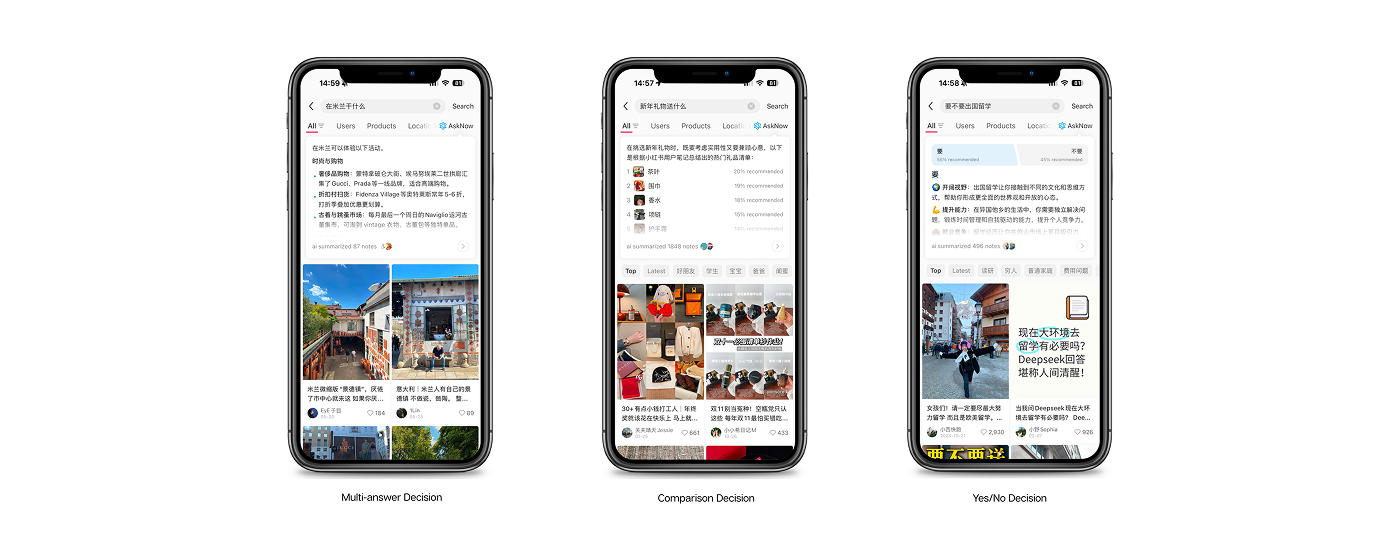Contact


RedNote is evolving its core value proposition, moving from simply exploring trends and news to actively driving customer decisions.
Imagine you're a Chinese user planning a family trip to Tokyo. Before, you'd use ChatGPT for a logical "5-day, family-friendly itinerary," then switch to Rednote for real, on-the-ground details. Now, Rednote supercharges your planning by integrating AI engines like ChatGPT directly into its platform. Get the best of both worlds: AI provides the strategy, and Rednote delivers the authentic, user-generated details.
But this shift isn't just about planning better trips. For brands, it represents a fundamental change in how consumers make decisions. What should brands know about Rednote's evolution from "searching for content" to "asking AI"?

Simply put, these three models form a complete decision-making chain that progresses from "exploration" to "evaluation" and finally to "decision." The core distinction lies in the clarity of user needs and the complexity of the decision-making process.

Multi-answer Decision
• User Mindset Model: "I have vague needs and require inspiration and options."
• Core Content Strategy: Breadth and Inspiration
• Formats: "10 Options for XXX," "Collection of Niche Gems in XXX," "N Ways to Enjoy XXX."
• Key Points: Content should be extensive, novel, and comprehensive, covering different styles, price points, and scenarios. The goal is to give users a sense of surprise: "Wow, I never knew it could be like this!"
Comparison Decision
• User Mindset Model: "I've narrowed down a few options but can't decide which one to choose."
Users are in the evaluation stage of decision-making. Having narrowed their options through "multi-answer decision-making," they now need specific, comparable information to make a final choice. Their goal is to resolve the "paradox of choice."
• Core Content Strategy: Depth and Pros/Cons
Formats: "In-Depth Review: A vs. B," "Comparative Review of 3 Popular XXX Models: Which Offers the Best Value?"
• Key Points: Content must be objective, impartial, and clearly structured. It should provide direct comparisons across dimensions such as price, features, user experience, and target audience, ultimately offering persuasive conclusions or recommendations.
Yes/No Decision
• User Mindset Model: "I have doubts about a single option and need to assess its value or risks."
Users are facing a binary choice (yes or no), but this decision often involves high costs, high risks, or emotional factors. They need someone to help them analyze the pros and cons, providing either reassurance or a reason to reconsider.
• Core Content Strategy: Value and Resonance
Formats: "I Spent 30,000 on XXX Do I Regret It?", "Think Twice! 5 Types of People Who Should Avoid XXX", "Honest Talk: Weighing the Pros and Cons of XXX"
• Key Points: The content must feel highly authentic and relatable. It should openly share personal experiences, analyze the cost-benefit ratio, highlight potential risks, and ultimately help users determine whether the choice is "worth it."
A healthy content ecosystem should simultaneously cover all three models. Rednote's AI precisely identifies these distinct decision-making patterns to recommend the most suitable content to users at different stages of their decision journey, thereby significantly enhancing both the platform's user experience and commercial efficiency.
For brands, the imperative is clear. Success is no longer just about being discovered; it's about being relevant at the precise moment a user is ready to engage. By strategically crafting content for the multi-answer, comparison, and yes/no decision funnels, brands can position themselves within Rednote's AI-driven ecosystem to meet users exactly where they are.

